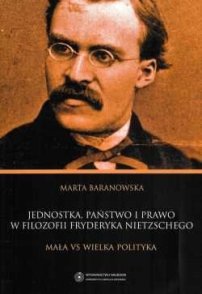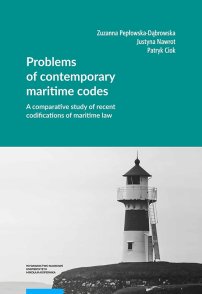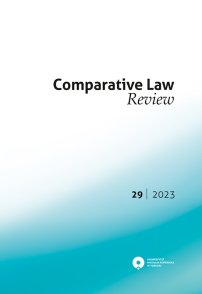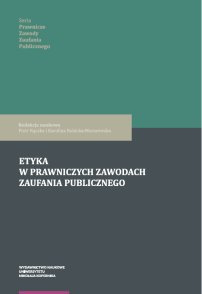Outline of Polish collective labour law
Rok wydania:2024
Nr wydania:Wydanie pierwsze
Liczba stron:250
ISBN:978-83-231-5392-4
eISBN:978-83-231-5393-1
Format:228 x 158
DOI:
https://doi.org/10.12775/978-83-231-5393-1
OPIS
The intention of the authors of this publication was to give an overview of the complex and multifaceted issues of collective labour law in Poland. The work refers in particular to the concept, features and functions of collective labour law and the principles of collective labour law that reveal the face of this law. Its subject is also social dialogue, which binds together almost all institutions of collective labour law, autonomous sources of labour law and collective disputes. An important part of the monograph is the analysis of the close relationship between collective and individual labour law, as well as the discrepancies between the model of collective labour law and its operation in legal practice. The final part of the study concerns the nature of collective labour law. The problem in this respect relates to the extension of the right of trade union coalition to persons performing paid work on a basis other than employment relationships. This raises the important question of whether we are already dealing with collective employment law, or whether the concept of collective labour law is still in operation.
SPIS TREŚCI
Foreword / 9
List of abbreviations / 11
Chapter I. General characteristics of collective labour law / 15
1. The evolution of collective labour law / 15
2. The concept of collective labour law / 20
3. The place of collective labour law in the system of labour law norms and its systematics / 22
4. Collective labour law and social policy / 27
5. Sources of collective labour law / 30
6. Functions of collective labour law / 34
7. Features of collective labour law / 37
Chapter II. Social dialogue and instruments for its implementation / 43
1. Introduction to the issue of social dialogue in Poland / 43
2. The principle of social dialogue as a systemic premise of collective labour law / 47
2.1. Company dialogue / 47
2.2. Supra-company dialogue / 52
2.3. National dialogue / 54
2.4. Supranational dialogue / 57
3. Instruments for implementing the principle of social dialogue / 61
3.1. The principle of a limited role for the state in collective
labour relations / 61
3.2. Principle of representation of persons performing paid work and employers / 63
3.2.1. Representation of persons performing paid work / 63
3.2.1.1. Trade unions / 63
3.2.1.2. Employees’ non-union representation / 72
3.2.2. Employers’ organisations / 78
3.2.3. Principle of representativeness / 81
3.3. Collective labour disputes / 84
3.3.1. The concept and subject matter of a collective labour dispute / 84
3.3.2. Parties to a collective labour dispute / 87
3.3.3. Irenic methods of resolving collective labour disputes / 89
3.3.3.1. Conciliation / 89
3.3.3.2. Mediation / 91
3.3.3.3 Social arbitration (dispute adjudication) / 93
3.3.4. Non-irenic methods of resolving collective labour disputes / 95
3.3.4.1. Introduction / 95
3.3.4.2. Strike / 96
3.3.4.3. Industrial action other than strike / 100
3.3.4.4. Liability for organising and leading an illegal strike or other industrial action / 101
3.3.4.5. Problems with lockout / 102
3.4. Principle of equality (equivalence) of social partners / 103
3.5. Principle of employee participation in workplace management / 106
Chapter III. Autonomous sources of labour law / 111
1. Collective bargaining agreements / 111
2. Collective agreements other than collective bargaining agreements / 116
3. Regulations and statutes / 120
Chapter IV. Collective labour law or collective employment law? / 127
Bibliography / 131
List of legal acts / 145
List of judgements / 149
Internet sources / 151
List of abbreviations / 11
Chapter I. General characteristics of collective labour law / 15
1. The evolution of collective labour law / 15
2. The concept of collective labour law / 20
3. The place of collective labour law in the system of labour law norms and its systematics / 22
4. Collective labour law and social policy / 27
5. Sources of collective labour law / 30
6. Functions of collective labour law / 34
7. Features of collective labour law / 37
Chapter II. Social dialogue and instruments for its implementation / 43
1. Introduction to the issue of social dialogue in Poland / 43
2. The principle of social dialogue as a systemic premise of collective labour law / 47
2.1. Company dialogue / 47
2.2. Supra-company dialogue / 52
2.3. National dialogue / 54
2.4. Supranational dialogue / 57
3. Instruments for implementing the principle of social dialogue / 61
3.1. The principle of a limited role for the state in collective
labour relations / 61
3.2. Principle of representation of persons performing paid work and employers / 63
3.2.1. Representation of persons performing paid work / 63
3.2.1.1. Trade unions / 63
3.2.1.2. Employees’ non-union representation / 72
3.2.2. Employers’ organisations / 78
3.2.3. Principle of representativeness / 81
3.3. Collective labour disputes / 84
3.3.1. The concept and subject matter of a collective labour dispute / 84
3.3.2. Parties to a collective labour dispute / 87
3.3.3. Irenic methods of resolving collective labour disputes / 89
3.3.3.1. Conciliation / 89
3.3.3.2. Mediation / 91
3.3.3.3 Social arbitration (dispute adjudication) / 93
3.3.4. Non-irenic methods of resolving collective labour disputes / 95
3.3.4.1. Introduction / 95
3.3.4.2. Strike / 96
3.3.4.3. Industrial action other than strike / 100
3.3.4.4. Liability for organising and leading an illegal strike or other industrial action / 101
3.3.4.5. Problems with lockout / 102
3.4. Principle of equality (equivalence) of social partners / 103
3.5. Principle of employee participation in workplace management / 106
Chapter III. Autonomous sources of labour law / 111
1. Collective bargaining agreements / 111
2. Collective agreements other than collective bargaining agreements / 116
3. Regulations and statutes / 120
Chapter IV. Collective labour law or collective employment law? / 127
Bibliography / 131
List of legal acts / 145
List of judgements / 149
Internet sources / 151
Recenzje
Autorzy
Jan Piątkowski
Beata Rutkowska
PhD; Assistant Professor at the Department of Labour Law of Nicolaus Copernicus University in Toruń; author or co-author of scientific publications on individual and collective labour law issues. Her research interests focus on issues concerning the sources of labour law, as well as the institutions of collective labour law, with particular emphasis on employee representation.
Jagoda Jaskulska
PhD; Assistant Professor at the Department of Labour Law of Nicolaus Copernicus University in Toruń; author or co-author of scientific publications on labour and social law issues. Her research interests focus on issues of individual and collective labour law, as well as problems related to employment in medical entities and relations between labour law and civil law.
Powiązane

Książka
Oprawa miękka
Filozofia
Jednostka, państwo i prawo w filozofii Fryderyka Nietzschego. Mała vs wielka polityka
Marta Baranowska
64,00 zł

Książka
Wydanie papierowe
Prawo i administracja
Prawo karne i wymiar sprawiedliwości państw Unii Europejskiej. Wybrane zagadnienia
Andrzej Adamski, Janusz Bojarski, Piotr Chrzczonowicz, Marian Filar, Piotr Girdwoyń
69,00 zł
48,30 zł

Książka
Prawo i administracja
Problems of contemporary maritime codes. A comparative study of recent codifications of maritime law
Zuzanna Pepłowska-Dąbrowska, Justyna Nawrot, Patryk Ciok
od 6,92 zł

czasopismo
Open access
Comparative Law Review, t. 29/2023
Michał Balcerzak
za darmo
1/
Inne z tej kategorii
NOWOŚĆ

Książka
Oprawa miękka
Prawo i administracja
Obowiązki edukacyjne. Analiza administracyjnoprawna
Dominika Zawacka-Klonowska
56,00 zł
NOWOŚĆ

Książka
Prawo i administracja
Kluby i związki sportowe w Polsce. Aktualne problemy prawne
od 23,00 zł
NOWOŚĆ

Książka
Prawo i administracja
Kompetencje Rzecznika Praw Obywatelskich w zakresie kontroli uchwał organów stanowiących jednostek samorządu terytorialnego
Marcin Dorochowicz
od 23,00 zł
NOWOŚĆ

Książka
Prawo i administracja
Etyka w prawniczych zawodach zaufania publicznego
od 28,00 zł
1/






